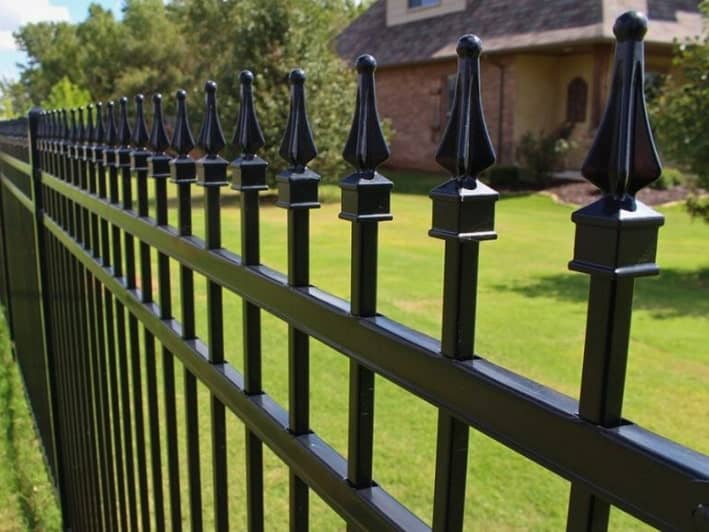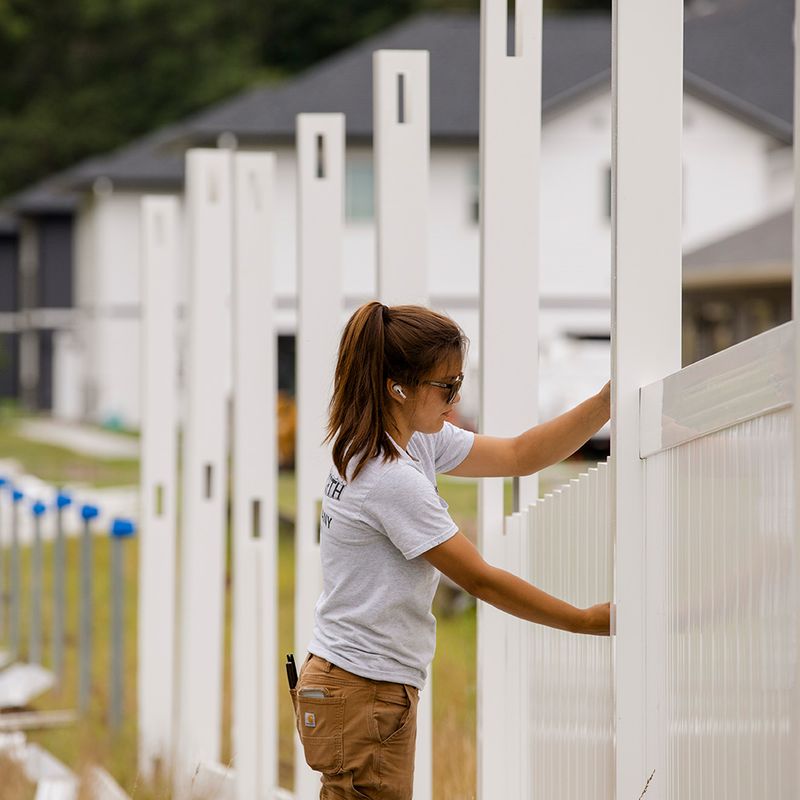How to Select the Ideal Fence Contractor for Your Backyard Project
Wiki Article
Just How to Determine Usual Concerns That Need Immediate Fence Fixing
When it involves maintaining your fencing, it is critical to find concerns prior to they become larger problems. Consistently examining for signs of decaying wood, leaning panels, or corrosion can conserve you money and time over time. You could not realize just how weather and bugs can endanger your fencing's stability. Allow's check out the usual indications that indicate your fence needs instant attention, so you can keep your home protected and looking its finest.Indications of Rotting Timber in Wooden Fences
Have you noticed your wooden fencing looking a little bit shabby? If so, it could be time to inspect for indications of decomposing wood. First, analyze the base of the articles and panels for soft areas. If you continue the timber and it feels spongy or falls apart, that's a clear indicator of rot. Next, try to find staining or dark spots on the wood-- these often signal moisture damages. Focus on any peeling off paint or coating, as this can reveal the timber to further degeneration. In addition, a poignant, stuffy smell can indicate fungal development. Do not forget to check joints and links; if they're loose or crumbling, the wood underneath is likely compromised. By capturing these signs early, you can avoid extra extensive damages and maintain your fence standing strong. Regular maintenance is vital to prolonging the life of your wooden fencing.Leaning or Tilting Fencing Panels
If you've noticed your fence panels tilting or leaning, it's vital to recognize what triggered it. This issue might show underlying architectural damage that requires your interest. Let's discover the usual reasons and the repair choices readily available to obtain your fencing back fit.
Reasons For Leaning Panels
It's typically an indication of underlying concerns that require attending to when you discover your fencing panels leaning or tilting. One common reason is inadequate drain; too much water can erode the soil around the fence posts, weakening their support. One more offender might be strong winds or storms that press against the panels, specifically if they're not effectively secured. Additionally, the all-natural settling of dirt with time can cause articles to move, causing a tilt. Pests, like termites, can compromise the stability of wooden panels, creating them to lean as well. Lastly, inadequate installation methods might lead to panels not being firmly set, leaving them vulnerable to leaning under pressure. Address these concerns promptly to preserve your fence's stability.
Indicators of Architectural Damages
Seeing leaning or tilting fencing panels can be disconcerting, as these problems often suggest architectural damage that requires prompt focus. When your fence starts to lean, it may signal that the posts are moving or that the soil around them has worn down. Pay attention to voids between blog posts or panels, as these can likewise recommend instability. deck builder. In addition, look for fractures or splintering in the wood, which can damage the general framework. It might jeopardize the stability of the fence if you notice corrosion or corrosion on steel components. Keep in mind, ignoring these indicators can result in much more extreme damages down the line, so it's necessary to evaluate the scenario quickly and do something about it prior to it worsensRepair Options Available

Rust and Corrosion in Metal Fences
If you have a steel fence, you could observe corrosion and rust creeping in in time, specifically if it's revealed to moisture. These problems not just affect the look of your fencing but can likewise compromise its architectural honesty. To determine corrosion, search for reddish-brown areas or spots, which suggest the steel is oxidizing. Deterioration can spread out quickly if left neglected, leading and damaging the fence to costly repairs.To tackle rust and corrosion, you ought to clean the affected locations with a cord brush and apply a rust-inhibiting guide. Once the guide dries out, take into consideration repainting the fencing with a weather-resistant paint to secure it even more. Routine upkeep, such as inspecting for signs of rust and touching up paint as required, will assist prolong your fencing's life expectancy. Dealing with these concerns quickly guarantees your metal fence stays strong and aesthetically appealing for years to find.Cracks and Divides in Plastic Secure Fencing

Sources Of Vinyl Damage
Vinyl fence is prominent for its durability, yet it can still experience from cracks and divides because of different variables. One significant reason is severe temperature level variations. When vinyl expands in the heat and contracts in the cool, it can damage the product in time. In addition, direct exposure to severe sunlight can lead to UV degradation, making the vinyl breakable. Physical impacts, like unintentional accidents or hefty branches, can also produce cracks. Poor installation or utilizing low-grade products can worsen these issues. Additionally, age contributes; older vinyl secure fencing is a lot more prone to damages. Regular inspections can help you recognize these variables before they lead to significant troubles. Take positive procedures to ensure your fence continues to be undamaged and solid.Repairing Cracks Efficiently
Although splits and splits in your vinyl fencing can be worrying, addressing them without delay can stop further damage and keep the fence's look. Analyze the size of the split. For small fractures, a vinyl repair work kit usually consists of sticky that can bond the sides, providing a smooth fix. Clean the area thoroughly prior to using the adhesive, ensuring it sticks effectively. For larger divides, you may need to make use of a vinyl patch. Cut the spot to dimension, apply sticky around the edges, and press it securely onto the split. Permit it to heal according to the supplier's directions. Normal upkeep and quick repair work can extend your fence's lifespan, keeping it looking wonderful for several years to come.Loose or Missing Fencing Articles
Missing or loosened fencing articles can weaken the security of your entire fencing structure. If you see any blog posts leaning or tottering, it's necessary to address the concern promptly. Inspect for any indications of movement, as this can bring about more damages in time. You can quickly evaluate the trouble by offering each article a gentle shake-- if it feels unstable, it's time to take action.For missing blog posts, you'll require to change them as soon as feasible to preserve your fence's stability. When you set up brand-new articles, see to it they're firmly secured in the ground with concrete or gravel for added stability. If a post is loose, tighten it by including read more additional support or driving it deeper right into the ground.Ignoring these issues can cause larger issues, like gaps in your fencing or also full collapse. So, watch on your messages and stay proactive about fixings!Damage From Weather and Natural Environment
Weather and natural elements can damage your fencing, causing numerous forms of damages that call for prompt focus. Heavy rainfall can trigger wood to rot, making it weak and unstable. Snow build-up might flex or break panels, while solid winds can root out fence messages or trigger areas to lean.If you observe fractures or splintering in wood fencings, it suggests drying due to extreme sun direct exposure. Steel fencings can rust if safety coatings wear off, especially in humid or seaside areas.Inspect your fencing frequently after storms or severe weather to capture any type of damage early. Resolving these concerns swiftly can save you from pricey repairs down the line. Don't wait till a little problem becomes a major one; stay positive and maintain your fencing in leading form to keep both capability and visual allure.Parasite Problem and Termite Damages
When you notice indications of bug problem or termite damage, it's necessary to act swiftly to stop additional destruction. Look for mud tubes along your fence or hollow-sounding timber, as these indicate termites go to job. You may also see tiny holes or frass, which is termite droppings resembling sawdust. If you spot any one of these signs, it's time to assess the damage.Don' t delay until it's as well late; pests can endanger your fence's stability. Inspect the surrounding location for ants or beetles, as they may be contributing to the issue. If you suspect a problem, think about speaking to a parasite control expert to treat the issue.repairing and verify or changing damaged sections of your fence without delay not only recovers its strength however additionally avoids pests from spreading out better. Keep watchful to keep your residential property secure and pest-free.Often Asked Inquiries
Just how Commonly Should I Check My Fencing for Damage?
You must inspect your fencing at least twice a year, ideally throughout spring and autumn. Routine checks help you identify damage early, saving you time and money on fixings while keeping your property's appearance and security.Can I Repair a Fence Myself or Hire a Specialist?
If you have the right devices and skills, you can absolutely fix a fencing on your own. Hiring a professional assurances quality job and conserves you time, especially for complex repair work or extensive damage.What Equipment Are Needed for Basic Fencing Fixings?
For basic fence repairs, you'll require tools like a hammer, screwdriver, pliers, a saw, a level, and determining tape. deck builder. Relying on the fixing, you might also require nails, screws, or substitute boardsJust How Much Does Fencing Fixing Commonly Expense?
Fence fixing prices vary extensively, but you can expect to pay in between $200 and $1,500 depending upon materials, labor, and level of damages. It's smart to get numerous quotes for the very best deal.
When Is the most effective Season for Fence Fixes?
The most effective time for fencing repair work is throughout moderate weather condition, typically in spring or early autumn. You'll stay clear of extreme temperature levels, making it much easier to function and making sure the products established appropriately for lasting resilience (deck builder). Observing leaning or turning fence panels can be disconcerting, as these problems usually suggest architectural damages that needs immediate attention. Loose or missing fencing articles can undermine the security of your entire fencing structure. Snow build-up might bend or break panels, while strong winds can root out fence messages or cause areas to lean.If you see splits or splintering in wooden fences, it's an indication of drying out due to intense sunlight direct exposure. Metal fences can rust if protective coatings use off, especially in seaside or humid areas.Inspect your fence consistently after tornados or extreme climate to catch any kind of damage early. Fence repair costs vary widely, yet you can anticipate to pay in between $200 and $1,500 depending on materials, labor, and extent of damagesReport this wiki page